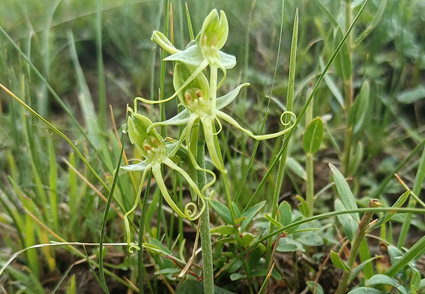Abstract
Habenaria qinghaiensis, a new species of Orchidaceae from Qinghai Province, is described and illustrated. Molecular phylogenetic analysis based on nuclear ITS (nrITS) and two plastid (matK and rbcL) DNA markers indicates that H. qinghaiensis belongs to H. josephi group (sect. Diphyllae s.l.). It is morphologically similar to H. josephi and H. tibetica, but differs from the former by having petals shallowly 2-lobed at base, lateral lobes of lip 1.8–2.2 cm long, lip with cushion-like appendage at entrance of spur, and from the latter by having almost glabrous bracts, petals and ovary, lip with cushion-like appendage at entrance of spur, and three stigmas.
References
Chase, M.W., Cameron, K.M., Freudenstein, J.V., Pridgeon, A.M., Salazar, G., van den Berg, C. & Schuiteman, A. (2015) An updated classification of Orchidaceae. Botanical Journal of the Linnean Society 177: 151–174. https://doi.org/10.1111/boj.12234
Cruz-Lustre, G., Castro, C., Borba, E.L. & Nogueira Batista, J.A. (2022) Phylogenetics and taxonomy of Habenaria sect. Micranthae (Orchidaceae), with the description of an overlooked new species from the Espinhaco mountain range, Eastern Brazil. Systematics and Biodiversity 20: 1–20. https://doi.org/10.1080/14772000.2022.2030424
Deng, H., Zhang, G.Q., Liu, Z.J. & Wang, Y. (2015) A new species and a new combination of Phalaenopsis (Orchidaceae: Epidendroideae: Aeridinae): evidence from morphological and DNA analysis. Phytotaxa 238 (3): 243–254. https://doi.org/10.11646/phytotaxa.238.3.3
Govaerts, R., Bernet, P., Kratochvil, K., Gerlach, G., Carr, G., Alrich, P., Pridgeon, A.M., Pfahl, J., Campacci, M.A., Holland Baptista, D., Tigges, H., Shaw, J.C., Alex George, P., Kreuz, K. & Wood, J. (2021) World checklist of Orchidaceae. [http://wcsp.science.kew.org/]
IUCN (2022) Guidelines for Using the IUCN Red List Categories and Criteria. Version 15.1. Available from: https://www.iucnredlist.org/resources/redlistguidelines (accessed 12 October 2022)
Jin, W.T., Jin, X.H., Schuiteman, A., Li, D.Z., Xiang, X.G., Huang, W.C., Li, J.W. & Huang, L.Q. (2014) Molecular systematics of subtribe Orchidinae and Asian taxa of Habenariinae (Orchideae, Orchidaceae) based on plastid matK , rbcL and nuclear ITS. Molecular phylogenetics and evolution 77: 41–53. https://doi.org/10.1016/j.ympev.2014.04.004
Jin, W.T., Schuiteman, A., Chase, M.W., Li, J.W., Chung, S.W., Hsu, T.C. & Jin, X.H. (2017) Phylogenetics of subtribe Orchidinae s.l. (Orchidaceae; Orchidoideae) based on seven markers (plastid matK, psaB, rbcL, trnL-F, trnH-psba, and nuclear nrITS, Xdh): implications for generic delimitation. BMC plant biology 17: 222. https://doi.org/10.1186/s12870-017-1160-x
Kalyaanamoorthy, S., Minh, B.Q., Wong, T.K.F., Haeseler, A.N. & Jermiin, L.S. (2017) ModelFinder: fast model selection for accurate phylogenetic estimates. Nature Methods 14: 587–589. https://doi.org/10.1038/nmeth.4285
Lin, D.L., Ya, J.D., Schuiteman, A., Ma, C.B, Liu, C., Guo, X.L., Chen, S.S., Wang, X.L., Zhang, Z.R., Yu, W.B. & Jin, X.H. (2021) Four new species and a new record of Orchidinae (Orchidaceae: Orchideae) from China. Plant Diversity 43: 390–400. https://doi.org/10.1016/j.pld.2021.05.003
Miller, M.A., Pfeiffer, W.T. & Schwartz, T. (2010) “Creating the CIPRES Science Gateway for inference of large phylogenetic trees” in Proceedings of the Gateway Computing Environments Workshop (GCE). New Orleans, LA, pp. 1–8. https://doi.org/10.1109/GCE.2010.5676129
Ngugi, G., Le Pechon, T., Martos, F., Pailler, T., Bellstedt, D.U. & Bytebier, B. (2020) Phylogenetic relationships amongst the African genera of subtribe Orchidinae s.l. (Orchidaceae; Orchideae): Implications for subtribal and generic delimitations. Molecular phylogenetics and evolution 153: 106946. https://doi.org/10.1016/j.ympev.2020.106946
Pandey, T.R. & Jin, X.H. (2021) Taxonomic revision of Habenaria josephi group (sect. Diphyllae s.l.) in the Pan-Himalaya. PhytoKeys 175: 109–135. https://doi.org/10.3897/phytokeys.175.59849
Pedron, M., Buzatto, C.R., Ramalho, A.J., Carvalho, B.M., Radins, J.A., Singer, R.B. & Batista, J.A.N. (2014) Molecular phylogenetics and taxonomic revision of Habenaria section Pentadactylae (Orchidaceae, Orchidinae). Botanical Journal of the Linnean Society 175: 47–73. https://doi.org/10.1111/boj.12161
Reichenbach, H.G. (1888) Habenaria josephi Rchb.f. Transactions of the Linnean Society of London, 3(1). Botany. London, p. 114.
Schlechter, F.R.R. (1922) Habenaria tibetica Schltr. Repertorium Specierum Novarum Regni Vegetabilis. Centralblatt für Sammlung und Veroffentlichung von Einzeldiagnosen neuer Pflanzen. Beihefte 12: 338.
Stamatakis, A. (2014) RAxML version 8: a tool for phylogenetic analysis and post-analysis of large phylogenies. Bioinformatics 30: 1312–1313. https://doi.org/10.1093/bioinformatics/btu033
Willdenow, C.L. (1805) Habenaria Willd 4(1). Species Plantarum. Editio Quarta. Berolini [Berlin], 5(44).
Zhang, D., Gao, F., Jakovli?, I., Zou, H., Zhang, J., Li, W.X. & Wang, G.T. (2020) PhyloSuite: An integrated and scalable desktop platform for streamlined molecular sequence data management and evolutionary phylogenetics studies. Molecular Ecology Resources 20: 348–355. https://doi.org/10.1111/1755-0998.13096
Zhou, Z.H., Shi, R.H., Zhang, Y., Xing, X.K. & Jin, X.H. (2021) Orchid conservation in China from 2000 to 2020: Achievements and perspectives. Plant Diversity 43: 343–349. https://doi.org/10.1016/j.pld.2021.06.003


